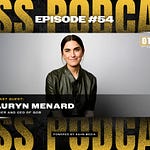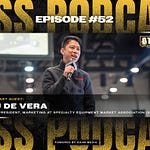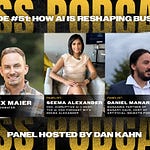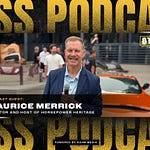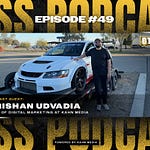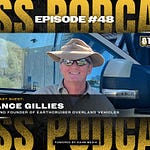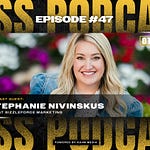The Roadster Shop’s Josh Henning, Jeremy Gerber and Phil Gerber on “Only The Strong Survive”
Josh Henning, Jeremy Gerber and Phil Gerber are the team behind Roadster Shop and the “Oil & Whiskey” podcast. Now known as one of the premier manufacturers of high-end chassis for hot rods, muscle cars, trucks and customs, the road to the top wasn’t an easy one. Both Jeremy and Phil started working in their father’s autobody shop at a young age, learning the ins and outs of the trade. That formative experience was vital in determining that there wasn’t enough passion in the body shop business. The brothers left to pursue separate interests, and eventually, their father came to the same conclusion. Looking for something new, the eldest Gerber purchased the Roadster Shop in 2004.
The family reunited again to run Roadster Shop but had their work cut out for them. Roadster Shop didn’t have the best reputation for quality at the time of the purchase, and a lot had to be done to overcome that. Eventually, Josh Henning was brought on board to assist with propelling the brand forward. In this episode of the “Only The Strong Survive” podcast, the trio sit down with host Dan Kahn to discuss what they have learned from transforming Roadster Shop from its humble origins into a premier brand. The episode is worth listening to for anyone looking to build their own brand or transform an existing one. Click on the play icon to listen to the entire episode, and here are our top five takeaways:
Passion is great, but you also have to pay the bills.
You can learn more from your mistakes than your wins.
Always maintain focus on your customers.
Rebuilding a brand can be as challenging as starting a new one.
Drive demand with your products instead of waiting for it to build.
Start From Scratch or Rebuild?
When the Gerbers bought the Roadster Shop, it was much smaller and very old-school. Chassis blueprints were often drawn by hand and built in a low-tech manner. This antiquated approach led to many quality problems and customer complaints. All those issues had to be addressed, and the brand’s reputation would have to be rebuilt before pushing it forward. Naturally, this raised the question of whether it would have been better to start from scratch with a new brand. The answer is nuanced.
“It’s tough to say. Realistically, yes, it would have been so much easier to start from scratch. The missing element there would have been the chassis business, though. For us, that wouldn’t have been something that we would have opened up,” says Jeremy. “The fact that it existed in some capacity drove us to improve it and make it better and better.”
Passion Vs. Profit
Building cool cars is a passion for everyone at the Roadster Shop. However, the team figured out early on that producing a few cars a year wouldn’t pay the bills. They would also have to compete against well-established shops already building cars. Focusing on creating high-quality chassis in a larger volume was a better business model, and it still allowed them to pursue their passion for building cars to showcase their latest products.
“Where it started to where it ended is probably a complete 180-degree flip. We started off just wanting to build the coolest cars out there,” says Phil. “At some point, it just kind of hit us that we could build these amazing cars, but we couldn’t sell another one. It is impossible to duplicate that car; if you did, it wouldn’t be the same. People always wanted some crazy one-off taillight or door handle that we made that you couldn’t really sell. What we could sell is really what set the stage for the whole build, and that was the chassis.”
Proactively Driving Demand
Many businesses respond to customer demand with their products. While doing so is always a good idea, it is also a reactive business model. You have to wait for that demand to develop. However, if you understand your customers and can skillfully create enough interest, you can drive demand through the right new products.
“Now, we have gotten to the point where we are creating market demand. Historically, we would see where it went and what our customers wanted,” says Phil. “It would take someone to build that first ‘oh shit’ car for everyone to get inspired by, and then the market starts going after that. We’ve taken a good amount of that into our business plan, and we always try to come out with something that’s over the top and really in your face to kick off a new product.”
Focus on Your Customers
It can be easy to lose focus in the day-to-day grind of running a business. However, getting sidetracked by details and items that don’t really matter in the bigger picture can be absolutely detrimental. One of the biggest keys to success with any brand is maintaining a laser-like focus on your customers and their satisfaction.
“Don’t chase the stupid shit that doesn’t mean anything,” says Henning. “Always make your customer happy. There’s always the extra mile that you can go with your labor even when the customer’s pocketbook runs out.”
Learn From Your Mistakes
In a perfect world, none of us would ever make a mistake. However, we are all human, and mistakes will happen until AI-powered robots replace us. According to Phil, the key is to learn anything you can from those mistakes to improve your business. You can then put guardrails and corrections in place to prevent those mistakes from happening again.
“I think the biggest mistake is not learning from your mistakes. We screw stuff up, and I have always learned from every mistake,” says Phil. “You get bitten once, you get bitten hard and you are never going to do that again. If you don’t pay attention or if you are stupid enough to do it again, it is going to hurt way worse the second or third time. So, learn from what you did and use it as a teaching moment. You can always grow significantly better and learn much more from your mistakes than your victories.”





